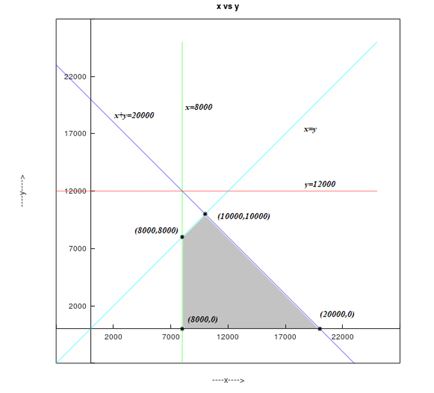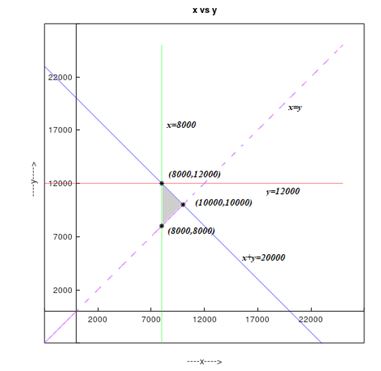
Concept explainers
Return on Investment An investment broker is instructed by her client to invest up to , some in a junk bond yielding per annum and some in Treasury bills yielding per annum. The client wants to invest at least in T-bills and no more than in the junk bond.
(a) How much should the broker recommend that the client place in each investment to maximize income if the client insists that the amount invested in T-bills must equal or exceed the amount placed in the junk bond?
(b) How much should the broker recommend that the client place in each investment to maximize income if the client insists that the amount invested in T-bills must not exceed the amount placed in the junk bond?
To solve: The given linear programming problem.
Answer to Problem 23AYU
Solution:
a. The maximum return on investment is , when is invested in T-Bills and is invested in junk bond.
Explanation of Solution
Given:
- Total investment upto .
- Minimum investment in Treasury Bills .
- Maximum investment in junk bond .
- Interest from Treasury Bills .
- Interest from junk bond .
Calculation:
Begin by assigning symbols for the two variables.
Amount invested in T-Bills.
Amount invested in junk bond.
a. If is the total return from both the investment, then
The goal is to maximize subject to certain constraints on and . Because and represents the amount, the only meaningful values of and are non-negative.
Therefore, .
From the given data we get
Therefore, the linear programming problem may be stated as
Maximize
Subject to
The graph of the constraints is illustrated in the figure below.

| Corner points are | Value of objective function |
The maximum return on investment is , when is invested in T-Bills and is invested in junk bond.
To solve: The given linear programming problem.
Answer to Problem 23AYU
Solution:
b. The maximum return on investment is , when is invested in T-Bills and is invested in junk bond.
Explanation of Solution
Given:
- Total investment upto .
- Minimum investment in Treasury Bills .
- Maximum investment in junk bond .
- Interest from Treasury Bills .
- Interest from junk bond .
Calculation:
Begin by assigning symbols for the two variables.
Amount invested in T-Bills.
Amount invested in junk bond.
b. If is the total return from both the investment, then
The goal is to maximize subject to certain constraints on and . Because and represents the amount, the only meaningful values of and are non-negative.
Therefore, .
From the given data we get
Therefore, the linear programming problem may be stated as
Maximize
Subject to
The graph of the constraints is illustrated in the figure below.

| Corner points are | Value of objective function |
The maximum return on investment is , when is invested in T-Bills and is invested in junk bond.
Chapter 11 Solutions
Precalculus
Additional Math Textbook Solutions
University Calculus: Early Transcendentals (4th Edition)
Thinking Mathematically (6th Edition)
Pre-Algebra Student Edition
Elementary Statistics (13th Edition)
Algebra and Trigonometry (6th Edition)
Calculus: Early Transcendentals (2nd Edition)
- Can you help explain what I did based on partial fractions decomposition?arrow_forwardSuppose that a particle moves along a straight line with velocity v (t) = 62t, where 0 < t <3 (v(t) in meters per second, t in seconds). Find the displacement d (t) at time t and the displacement up to t = 3. d(t) ds = ["v (s) da = { The displacement up to t = 3 is d(3)- meters.arrow_forwardLet f (x) = x², a 3, and b = = 4. Answer exactly. a. Find the average value fave of f between a and b. fave b. Find a point c where f (c) = fave. Enter only one of the possible values for c. c=arrow_forward
- please do Q3arrow_forwardUse the properties of logarithms, given that In(2) = 0.6931 and In(3) = 1.0986, to approximate the logarithm. Use a calculator to confirm your approximations. (Round your answers to four decimal places.) (a) In(0.75) (b) In(24) (c) In(18) 1 (d) In ≈ 2 72arrow_forwardFind the indefinite integral. (Remember the constant of integration.) √tan(8x) tan(8x) sec²(8x) dxarrow_forward
- Find the indefinite integral by making a change of variables. (Remember the constant of integration.) √(x+4) 4)√6-x dxarrow_forwarda -> f(x) = f(x) = [x] show that whether f is continuous function or not(by using theorem) Muslim_mathsarrow_forwardUse Green's Theorem to evaluate F. dr, where F = (√+4y, 2x + √√) and C consists of the arc of the curve y = 4x - x² from (0,0) to (4,0) and the line segment from (4,0) to (0,0).arrow_forward
 Calculus: Early TranscendentalsCalculusISBN:9781285741550Author:James StewartPublisher:Cengage Learning
Calculus: Early TranscendentalsCalculusISBN:9781285741550Author:James StewartPublisher:Cengage Learning Thomas' Calculus (14th Edition)CalculusISBN:9780134438986Author:Joel R. Hass, Christopher E. Heil, Maurice D. WeirPublisher:PEARSON
Thomas' Calculus (14th Edition)CalculusISBN:9780134438986Author:Joel R. Hass, Christopher E. Heil, Maurice D. WeirPublisher:PEARSON Calculus: Early Transcendentals (3rd Edition)CalculusISBN:9780134763644Author:William L. Briggs, Lyle Cochran, Bernard Gillett, Eric SchulzPublisher:PEARSON
Calculus: Early Transcendentals (3rd Edition)CalculusISBN:9780134763644Author:William L. Briggs, Lyle Cochran, Bernard Gillett, Eric SchulzPublisher:PEARSON Calculus: Early TranscendentalsCalculusISBN:9781319050740Author:Jon Rogawski, Colin Adams, Robert FranzosaPublisher:W. H. Freeman
Calculus: Early TranscendentalsCalculusISBN:9781319050740Author:Jon Rogawski, Colin Adams, Robert FranzosaPublisher:W. H. Freeman
 Calculus: Early Transcendental FunctionsCalculusISBN:9781337552516Author:Ron Larson, Bruce H. EdwardsPublisher:Cengage Learning
Calculus: Early Transcendental FunctionsCalculusISBN:9781337552516Author:Ron Larson, Bruce H. EdwardsPublisher:Cengage Learning





